

Australian20Video20Viewing20Report20Q4 2017. eSafety Commissioner. Supervising preschoolers online. Screen time: babies and toddlers. American Academy of Pediatrics (2016).
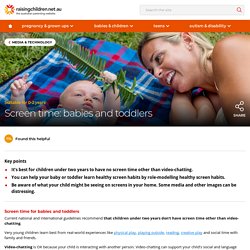
Media and young minds. Elk Grove Village, IL: AAP. doi: 10.1542/peds.2016-2591. Blum-Ross, A., & Livingstone, S. (2017). The trouble with ‘screen time rules’. London: LSE Department of Media and Communications. Blum-Ross, A., & Livingstone, S. (2016). Edwards, S., Straker, L., & Oakey, H. (2018). Heitner, D. (2016). Screen Time Still an Australian Pastime – Nielsen. The latest figures from the Australian Video Viewing Report from Regional TAM, OzTAM and Nielsen show the average Australian home now has 6.6 screens in which to consume video content.
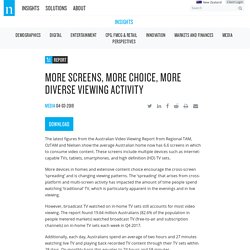
These screens include multiple devices such as internet-capable TVs, tablets, smartphones, and high definition (HD) TV sets. Australia: Average 6.4 screens per home. March 29, 2017 The Q4 (October-December) 2016 Australian Multi-Screen Report – from Regional TAM, OzTAM and Nielsen – continues to document how growing content, platform and screen choices have caused a gradual shift in the way consumers apportion their viewing across devices.

Australians are voracious consumers of broadcast TV and other video, and as of Q4 2016 had a dizzying array of options by which to do so. It was early days for many of these alternatives when the report was first published five years ago. While there is much discussion about television’s place in today’s screen mix, several trends are clear: More screens. On average Australians watch 2 hours and 39 minutes (2:39) of broadcast TV each day, or 81:18 per month. The TV set is not just for TV any more. Earlychildhood NEWS - Article Reading Center. We are always looking for the magic bullet, something that will solve all our problems.
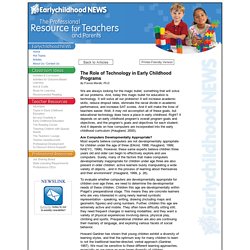
And, today this magic bullet for education is technology. It will solve all our problems! Using technology in service delivery to families, children and young people - Technology use in Australia. Internet connectivity has increased rapidly over recent years in Australia, particularly for young people.

The Australian Bureau of Statistics (ABS; 2012) reported that in 2010–11, 79% of Australians aged 15 years and older (including 96% of 18–24 year olds) had accessed the Internet in the previous twelve months. A recent national survey by Sensis and Australian interactive Media Industry Association (2012) reported that 98% of respondents had Internet access and 52% of those who had access used the Internet daily. The same study reported that access was almost universal for both regional and metropolitan locations across Australia, apart from Tasmania, where access was only slightly lower (94%). A concurrent rapid increase in Internet access via mobile devices, such as smartphones and tablets, has increased users’ access to Internet services from any location at any time. Box 2: Just because we can use social networking sites, should we?
Many Kids Under Age 1 Use Devices. Skills Every Child Will Need to Succeed in 21st century. Enhancing children’s learning through media and technology. That being said, this brings up a lot of questions.
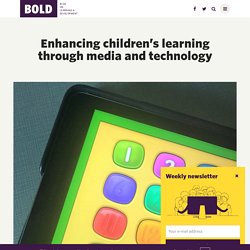
Are electronic storybooks actually helping children learn new vocabulary? Do children remember and learn from the lessons shown on Sesame Street? Are apps that are labelled as “educational” actually helping children to learn? A recent report in 2017 surveyed approximately 1400 parents living in the US to determine the patterns of media use among children between 0 and 8 years. Technology in early childhood education: Learning from screen media. Introduction Subject Infants and toddlers attend to screen media and are responsive to its sensory and perceptual features (movement, pace, bright color, music, and sound effects).6 Imitating their parents and older children, they will pick up a tablet or smartphone and tap and swipe to navigate the screen.
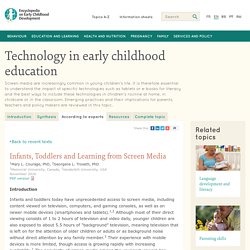
However, this does not mean that they understand or learn from the content.7 Although infants and toddlers are remarkably capable learners in direct social interaction,8 their language and story comprehension skills are limited and they are unlikely to follow the narrative content, story line, or content to be learned from a video or app.6 This contrasts with the potential of screen media to facilitate older children’s learning when the content is age appropriate, engaging, and educational.9 Problems.
How A Child Develops - Develop Skills. What is child development?
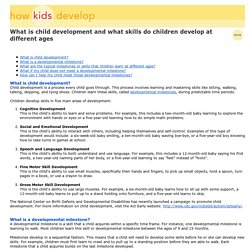
Child development is a process every child goes through. This process involves learning and mastering skills like sitting, walking, talking, skipping, and tying shoes. Children learn these skills, called developmental milestones, during predictable time periods. Children develop skills in five main areas of development: Cognitive Development This is the child's ability to learn and solve problems. What is a developmental milestone? Milestones develop in a sequential fashion. Technology in schools: Future changes in classrooms. Is technology 'transforming schools'?
I WANT MY iPAD! Are our kids getting addicted to technology? Are toddlers really becoming addicted to technology?
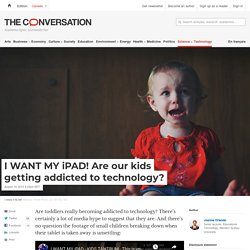
There’s certainly a lot of media hype to suggest that they are. And there’s no question the footage of small children breaking down when their tablet is taken away is unsettling: Footage such as this is often aimed at showing the evils of technology and the myriad ways digital devices engender bad behaviour among children. Viewers are often put in a position where they naturally try to apportion blame for such behaviour.
In this case, the apparent targets are the technology and even the parents. Scare tactics. Banning kids from using technology is counter-productive. Taiwan recently made the unprecedented move of banning children two years and younger from using any form of digital technology.
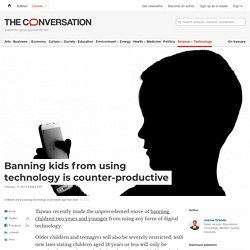
Older children and teenagers will also be severely restricted, with new laws stating children aged 18 years or less will only be permitted to use electronic devices for a “reasonable” length of time. What is “reasonable”, however, is yet to be defined. As with the use of any illegal substance or product, severe fines (in the vicinity of A$1,500) are in place for parents should their child break these new laws. This new ruling is a measure to limit children from potentially spending long hours in front of a screen. In neighbouring China, online addiction among young people has reached epidemic proportions. Speaking with: Joanne Orlando on children and technology. Is technology bad for kids? As more devices and software applications are made specifically for an increasingly younger audience, there is concern about the appropriateness of children using technology – and debate over when it should be introduced into their lives.
Yet at the same time, personal devices and touch screens are everywhere. How the iPad affects young children, and what we can do about it: Lisa Guernsey at TEDxMidAtlantic. Erikson Institute Technology and Young Children Survey. Key Aspects Of Learning. The Key Aspects of Learning, integral to the Primary National Strategy, are twelve essential ‘learning to learn’ skills. They include the Social and Emotional Aspects of Leaerning (SEAL): empathy, managing feelings, motivation, self-awareness and social skills.
The other seven are: communication, creative thinking, enquiry, evaluation, information processing, problem-solving and reasoning. ThinQ Education promotes the Key Aspects of Learning as essential skills for learning, leadership and life: essential not just for school but in preparing children for the rest of their lives. Communication Skills. Technology in early childhood education info. The Use of Technology in Early Childhood Classrooms. The use of technology in the classroom is increasing: Many teachers adopt technical devices in their early childhood classrooms helping them to support each child’s learning development more easily.
Technology plays a positive role in children’s development and learning. Through the use of technology, teachers have access to more innovative and improved teaching methods that allow them to promote learning and create an active learning environment for children. A new survey examined how teachers use technology in their early childhood classrooms. The researchers found that a majority of teachers integrate technical devices in their everyday teaching but that there is a need for support to use the devices more effectively. The Majority of Teachers Use Tables, Computers or Whiteboards in the Classroom The survey showed that 90% of the early childhood teachers have access to technology at school and use it regularly, with 88% saying that they use technical devices at least once a week. Early Childhood Australia Statement on young children and digital technologies - Early Childhood Australia. Technology and learning in the classroom: six tips to get the balance right.
Australia was one of the first countries in the world to have more computers than students in schools. But as the numbers of computers and other technological devices increased, student performance did not. The days of cramming computers into classrooms and expecting improvements in learning are numbered. Some argue there’s little evidence to justify investment in technology in the classroom. In fact, some studies even suggest potential harms. Some have suggested links between screen time and increased ADHD, screen addiction, aggression, depression, and anxiety, dizziness, headaches and blurred vision. Read more: No gimmicks: technology in schools must serve a purpose There is also a risk that schools’ focus on acquiring the “next best thing” may come at the expense of students’ interpersonal, cognitive, critical thinking and communication skill development. 1. Words are rarely used on their own on digital platforms now. 2.
Technology in the Classroom in 2019: 6 Pros & Cons. Technology in education is the biggest change in teaching we will ever see. For years, policy makers, teachers, parents and students alike have been weighing the potential benefits of technology in education against its risks and consequences. But now the debate is more pressing than ever, as curricula increasingly incorporate technology and professors experiment with new teaching methods. The Problem of Children and Technology: Getting Children Off Their Mobile Phones and Screens.
Digital policy statement. How technology is changing what it means to be human. Is there something unusual about the pace and nature of technological change today? Should we be more worried about the world we’re creating? Michael Bess is a historian of science at Vanderbilt University and the author of Our Grandchildren Redesigned: Life in a Bioengineered Society. His book offers a sweeping look at our genetically modified future, a future as terrifying as it is promising. But he’s also someone who thinks a lot about the broader relationship between technology and society. The role that technology plays in human life is becoming an increasingly urgent question.
I reached out to Bess to talk about our technological future and why he thinks we’re not asking the sorts of questions we should be asking about where we’re headed and what it will mean for humanity. A lightly edited transcript of our conversation follows. Sean Illing Since the invention of the printing press, people have always panicked about the implications of new technologies. Michael Bess. Technology and young children.